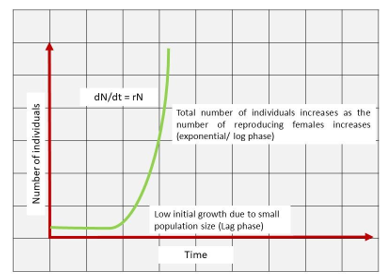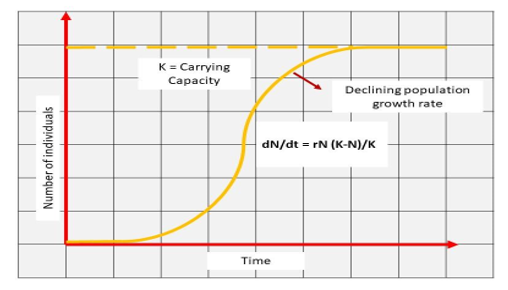Introduction
A population is a collection of people belonging to the same species who coexist in one location. These people are susceptible to the same environmental factors and need the same resources to survive and develop. When analyzing the population, we categorize the population based on its size and location.
A population is never constant and always exhibits some fluctuations. Natality, mortality, immigration, and emigration are some terms used to characterize these dynamic oscillations that occur in a population. Mathematical methods, such as the logistic growth models and the exponential growth curve, are used to study population dynamics.
Population Growth
The term “population growth” describes the shift in the total number of people within a population. This growth can be positive if the no.of individuals increases in an area and population growth can be termed negative if the no.of individuals decreases in an area.
Birth, immigration, death, and migration are the four main factors that influence change in the number of individuals in an area. The first two elements increase the population, whilst the latter two cause it to decrease.
Growth models that describe the basic growth trend in a population
There are two growth models which describe the basic growth trend in a population. The two models are-
Exponential Growth Model
- When an ideal environment with unlimited resources is taken into account, this growth model represents the rapid growth rate of a population.
- Under ideal circumstances, a small number of individuals would have the means to develop and propagate. This is because they are not constrained by any external forces.
- Every birth would result in an increase in population and every death will decrease the population.
- This model, is often employed to find out the maximum capacity of growth and the kind of ideal conditions required for such growth to take place.
Mathematically, it can be shown as follows-
\(\frac{{\Delta {\rm{ }}N{\rm{ }}}}{t} = {\rm{ r}} \times {\rm{N }}\; – – – – – 2\)
\(\frac{{\Delta {\rm{ }}N{\rm{ }}}}{t} = {\rm{ }}B{\rm{ }} – {\rm{ }}D{\rm{ }}\; – – – – – 1\)
Where \(\frac{{\Delta {\rm{ }}N{\rm{ }}}}{t}\)= change in population size(Δ N) over a time interval (t)
B – D = per capita number of births – per capita number of deaths
B – D can be substituted by the quantity r, hence the equation becomes:
\(\frac{{\Delta {\rm{ }}N{\rm{ }}}}{t} = {\rm{ r}} \times {\rm{N }}\; – – – – – 2\)
Applying differential calculus to the above equation, we get:
\(\frac{{{\bf{dN}}}}{{{\bf{dt}}}}{\rm{ }} = {\rm{ }}{\bf{rN}}\;\)
where r = per capita change in population size occurring at each instant of time / intrinsic rate of population growth
From this equation, the following cases arise:
- If r = 0, there’s no change in population size
- If r > 0, population size increases exponentially
- If r < 0, population size declines exponentially

Logistic Growth Model
- The Logistical Model is based on the notion that as an individual is “added” to a population, they have access to fewer resources, due division of resources amongst individuals. This is in contrast to the exponential model, which assumes limitless resources.
- Realistically, a certain geographic area can only support a certain number of inhabitants while ensuring that each has equal access to all available resources.
- This maximum limit of population growth that an environment can sustain is known as its carrying capacity, represented as (K).
- Limiting variables such as water, food, shelter, protection from predators, etc. govern the carrying capacity of an environment.
- The reproductive capacity of individuals is reduced when resources are scarce and the area is congested.
- Similar to this, factors like an increase in disease incidence can cause the per capita death rate to rise.
- Declining per capita population growth rate is the result of higher per capita mortality rates and lower per capita birth rates.
- Therefore, r decreases as N increases. In the logistic growth the model, per capita growth rate tends to 0 as population size approaches K.
- If (K-N) = no. of excess individuals that the environment can support, then
- (K-N)/K = the amount of K still available for population growth
\[\;{\rm{\;}}\frac{{{\rm{dN}}}}{{{\rm{dt }}}}{\rm{ = }}\frac{{{\rm{rN }}\left( {{\rm{K – N}}} \right)}}{{\rm{K}}}\;\]
Where dN/dt = rate of change in population size at time t
N = population density
r= intrinsic rate of growth under ideal conditions
K = carrying capacity

Factors that Influence Population Fluctuation:
The population is susceptible to regular dynamic variations brought on by the influx of new inhabitants into a region or the emigration of residents from that region. The following are the factors that influence population change.
- Natality- It is also known as birth rate and is defined as the number of children born in a certain area per unit of time. Natality rises when an organism reaches its maturity and declines as it nears senescence. There are two types of natality-
-
- Maximum/ absolute natality– This refers to the maximum number of persons that might theoretically be born under optimal and non-resource-limiting circumstances. It is also called the fecundity rate.
- Ecological/realized natality- This is the actual population growth brought on by births under given environmental circumstances. It is also known as the “fertility rate.”
- Mortality-It is also known as the death rate and is defined as the number of individuals that have died in a population per unit of time. There are two types of mortality-
- Specific or potential mortality- This refers to a theoretical decrease in the no. of indualivials under ideal climatic and resource availability conditions. People pass away through natural reasons, such as old age.
- Ecological/realized mortality-Ecological/realized mortality is the actual death of members of a population as a result of ongoing environmental issues and resource shortages. With changes in population and environment, this type of mortality keeps on changing.
- Immigration-
- The term “immigration” describes the flood of new people from other places into a new geographic area.
- It enhances population growth by increasing the number of individuals who already live in the area.
- Emigration
- Emigration is the movement of people away from a certain geographic area.
- It drives people out of the area, which decreases the local population there.
Summary
- Population growth refers to an increase in the number of people living in a particular location.
- Four significant factors—natality, death, immigration, and emigration—affect population growth.
- Models of population growth aid in analyzing and forecasting trends in population growth.
- The exponential model is theoretical since it is based on unlimited resource availability.
- The logistical model is realistic and takes into account the environment’s carrying capacity and limited resources.
- Natality is the number of children born in a region per unit of time.
- The number of individuals who die in a population per unit of time is known as mortality.
- Immigration is the movement of new people into a country or region from other places.
- Emigration is the movement of people out from a specific location.
Frequently Asked Questions
1. What benefits does population growth have?
Ans: Benefits of population growth are-
- Economic growth can be caused by population expansion.
- more parents are investing in their children as a result of more births.
- The economy is supported by rising spending on food, clothing, textbooks, recreational equipment, and toys.
2. What effects does population expansion have on the environment?
Ans: Population growth has the following impacts on the environment-
- The consumption of resources including land, food, water, air, fossil fuels, and minerals increases to a great extent.
- Lots of waste products are generated due to the consumption of various resources.
- Waste products such as hazardous substances, greenhouse gases, and air and water pollutants are also generated, harming the environment.
3. Mention different types of populations.
Ans: The different types of the population are-
- Finite population
- Infinite population
- Existent population
- Hypothetical population
 Mission Statement
Mission Statement
“Empower every student to achieve full potential”
88Guru has been established with the social objective of making quality video-based learning material available to all Indian students. Technology, Connectivity and Social Media are rapidly changing the world of Education and we wish to lead the transformation of the tuition industry in India.
88Guru is the perfect complement to the current tuition model. 88Guru creates a wonderful opportunity for children and parents to bond while engaging in a valuable learning activity. It also provides the complete curriculum at your fingertips for those moments when you need some help at short notice. We believe that this mode of tuition could be transformational, adding hours to a child's day while providing complete control over the learning process.
Every course is taught by the best teachers from India's top schools and conducted in an engaging manner to keep students involved. The e-learning process consists of video-based instructions, computer-graded assignments, and a dashboard which allows the student and parent to track progress.


